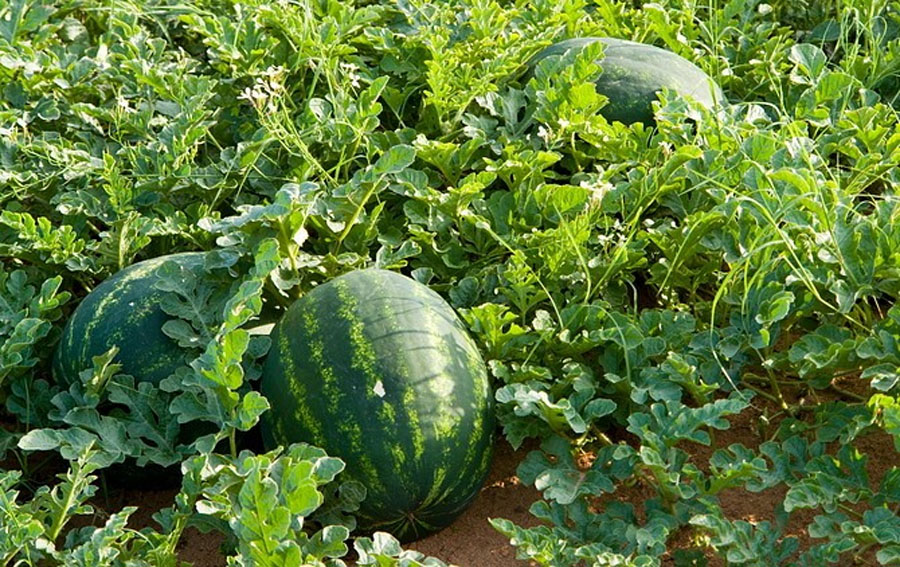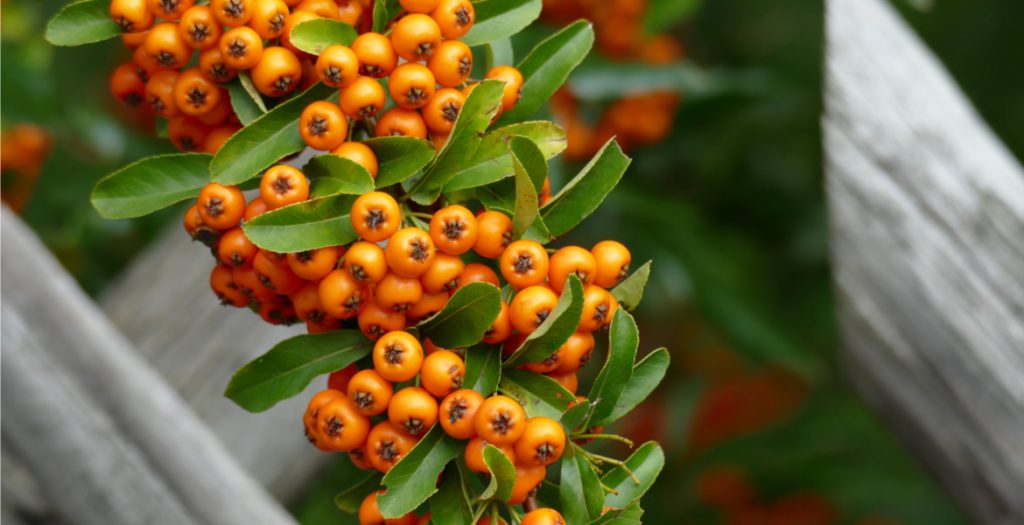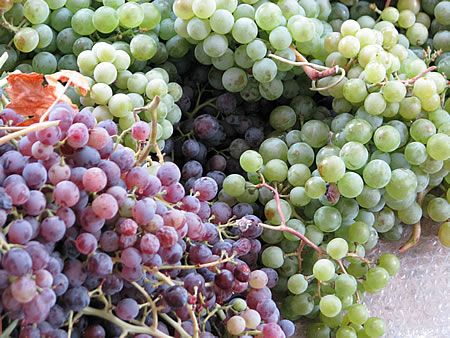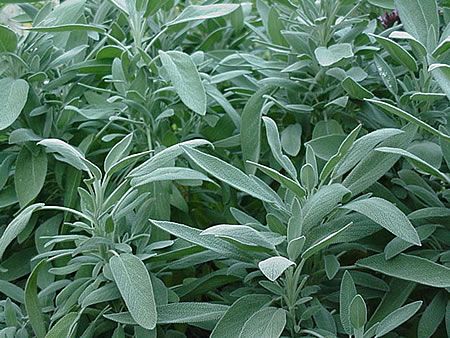“How do I grow watermelons in the garden?“, a neighbor asked me. “I see that you grow watermelons in your garden and I would like to try it myself“, he said.
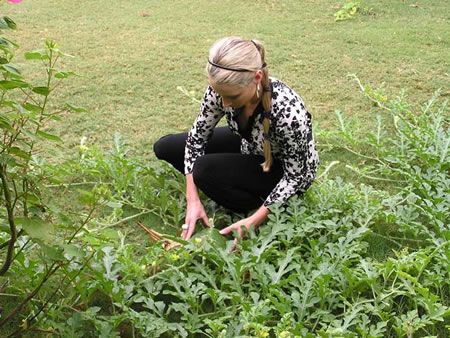
Watermelon is probably the most favorite and typical summer plant. Who wouldn’t want to have watermelons in their garden and taste their own juicy, red and sweet watermelons?
Watermelon is a climbing plant that loves heat very much. It grows best in warm climates where the temperature is at least between 21 and 27 degrees Celsius in the morning and 18 to 21 degrees Celsius at night. Male and female flowers grow on the same plant. They need the bees for pollination to take place.
Choosing a location for growing watermelon
Choose a part of the garden where it is constantly in the sun. If possible, choose a south-facing spot that is not caught in the wind. Watermelons like soil with a neutral pH, but will tolerate acidic soil where the pH is as low as 5.5.
Soil preparation
The soil where you will grow watermelon should be soft, well-drained and rich in nutrients.
You can follow two tactics to get good results even where the soil is not ideal.
Watermelons in pits
For each plant you plant, dig a pit 60 cm in diameter and 30 cm deep. Keep half of the soil from the pit and mix it with compost. Fill the pit, with this fluffy and nutrient-rich soil mixture.
Each pit should be spaced between 90 and 180 cm apart. The larger the fruit produced by the variety you grow, the greater the spacing should be. The fruit blossoms need space to grow.
Watermelons on hillsides
Lift the soil into hillocks and sow the seeds or seedlings on them. If you plan to grow a few watermelons, you can make a hillock for each plant. If you are growing a lot of watermelons, then the hills will be long and several plants will be grown on them in a row. As before, enrich the soil of the hillock with a generous amount of compost so that it has plenty of nutrients.
Forming the soil into hillocks keeps the soil soft and light so that the roots of the plant can grow easily. It allows for better aeration of the soil so that oxygen reaches the roots more easily. It helps in draining the extra water so that the roots do not rot.
Starting watermelons from seed
You should sow seeds when the soil and ambient temperature is consistently at least 21 degrees Celsius.
After you have obtained watermelon seeds from an agricultural store, from neighbors, from your uncle or grandfather in the village, drop them in water.
Don’t throw them all in the water! Estimate that in each place you have prepared you will plant 3 to 4 seeds.
Remove the floating seeds. They will not germinate.
Leave the seeds in the water for about half an hour and then plant them.
For even better results, you can do the following instead of plain water:
Fill a container one-third full with digested manure.
Fill the remaining two thirds with water.
Mix well.
Leave the mixture for a week, stirring frequently (e.g. every day). Attention! The smell is not pleasant.
Take some of this brown water and dip the seeds in it.
Remove the floating seeds. They won’t germinate.
Leave them for half an hour and then plant them.
You can also use the extra water for fertilizing. It has excellent results.
When the container is empty, just add more water and stir.
In the pit or hillock you have prepared, drill three holes about 2.5 cm deep. You can use your finger or a tool to drill the holes.
Put a seed in each hole and cover it with soil, which you will press down lightly.
If all goes well, after 7 to 10 days the seeds will germinate and the seedlings will appear. The germination time depends on the temperature, humidity and the depth at which they are buried. The soil should be permanently moist during the germination period.
One week after germination, remove the weakest plants. Keep 2 plants per pit or hillock.
Starting watermelons from seedlings
A good idea, especially if you are a beginner, is to start watermelon plants by buying ready-made seedlings grown in certified nurseries.
Plant the seedlings in the pits or hillsides you have prepared.
I would advise you to plant them 1 to 2 centimeters deeper than they were growing in their pockets. Water well after transplanting.
When do we plant watermelons?
Plant watermelons when the weather is warm enough and the soil temperature is consistently above 21 degrees Celsius. In Greece, this is usually after mid-April.
Suitable conditions for growing watermelons
Soil: Watermelons need nutrient-rich soil. The ideal pH is neutral (7.0), but they can tolerate up to 5.5.
Sun: the plant should be in a place where it can be exposed to the sun all day long, if possible.
Irrigation – Watering: Watermelons need a lot of water. They should be watered regularly.
Temperature: Watermelons need warm weather to grow.
Important information about watermelons
The first flowers that the watermelon will produce will fall off. Do not worry. They are the males. The watermelons, will be produced from the second flowers which are the females.
It’s not always easy to tell when the watermelon is ready to harvest. When the watermelon is ready, the bottom of the watermelon turns a pale yellow color. When you tap it with your palm, the sound is deep. On average, it takes 80 to 100 days for the plant to produce ripe fruit.
You can keep seeds from your watermelons. When the watermelon is edible, then the seeds are ready. Separate them, wash them well, dry them even better, and store them away from light and moisture. Next year you will be able to use them.
Additional information about watermelon
Watermelon (Citrullus lanatus) is a fruit that originated in southern Africa. The varieties consumed today can weigh several kilograms. The watermelon is smooth on the outside with a shade of green and sometimes with alternating dark and light green stripes. The rind is quite hard, about one centimeter thick and white inside. The main part of the inside of the watermelon is soft, red, contains a large number of black seeds (or white seeds) and contains large quantities of water.
The watermelon appears in hieroglyphics in ancient Egypt. In the 10th century AD it was cultivated in China and in the 13th century it appeared in Europe. The formal Greek word for the fruit is “Υδροπέπων” (corresponding to water-melon in English). The popular Greek word for watermelon is “Καρπούζι” and is derived from the Turkish word “karpuz”, which can be traced back to the Persian xarbuz(a).
Sources:
https://www.hunker.com/12544614/how-long-does-watermelon-take-to-grow-what-month-do-you-plant
https://www.wikihow.com/Grow-Watermelons
https://en.wikipedia.org/wiki/Watermelon
https://www.planetnatural.com/growing-watermelon/
Tags: CULTIVATE • CULTIVATION • SOW • WATERMELON • WATERMELONS

